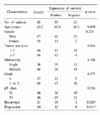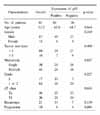Abstract
Purpose
The prognostic value of p53 remains controversial in transitional cell carcinomas of the bladder. Survivin, an inhibitor of apoptosis, is expressed in many human cancers. Recent studies have reported increased expression of survivin in superficial transitional cell carcinomas of the bladder. We investigated the expression of survivin and p53 and the clinical implications of this expression in superficial transitional cell carcinomas of the bladder.
Materials and Methods
Immunohistochemical staining of paraffin sections using a monoclonal antibody for survivin and p53 was performed in 82 cases of superficial transitional cell carcinomas of the bladder. Correlations between the expression of survivin and p53 and clinicopathological features, such as age, multiplicity of tumor, size, recurrence, and progression, were examined.
Results
Among 82 cases, positive survivin expression (greater than 20%) was observed in 59 cases. Positive p53 expression (greater than 20%) was observed in 46 cases. There were no significant differences in age, gender, multiplicity, tumor size, tumor grade, pT stage, recurrence, or progression-free survival between p53-positive and p53-negative groups (p>0.05). Also, there were no significant differences in age, gender, multiplicity, tumor size, tumor grade, or pT stage between survivin-positive and survivin-negative groups (p>0.05). However, recurrent-free and progression-free survivals were significantly lower in the survivin-positive group than in the survivin-negative group (p<0.05).
Figures and Tables
Fig. 1
Immunohistochemical staining of survivin in tissue sections obtained from superficial bladder tumor. (A) Survivin was observed diffusely in bladder tumor tissue. Reduced from ×40 (brown staining). (B) Reduced from ×200 (brown staining).

Fig. 2
Immunohistochemical staining of p53 in tissue sections obtained from superficial bladder tumor. (A) p53 was observed diffusely in bladder tumor tissue. Reduced from ×40 (brown staining). (B) Reduced from ×200 (brown staining).

Fig. 3
Kaplan-Meier cumulative recurrence-free and progression-free curves of patients with superficial bladder tumor according to the survivin immunoreactivity. There were significant differences in recurrence-free (p=0.015) and progression-free survival (p=0.046) between the surviving-positive and survivin-negative groups.

Fig. 4
Kaplan-Meier cumulative recurrence-free and progression-free curves of patients with superficial bladder tumor according to p53 immunoreactivity. There were no significant differences in recurrence-free (p=0.081) and progression-free survival (p=0.793) between the p53-positive and p53-negative groups.

References
1. Donat SM. Evaluation and follow-up strategies for superficial bladder cancer. Urol Clin North Am. 2003. 30:765–776.
2. Lee ES, Lee CK, Lee C. Prognostic factors in superficial bladder tumor. Korean J Urol. 1990. 31:795–801.
3. Heney NM, Ahmed S, Flanagan MJ, Frable W, Corder MP, Hafermann MD, et al. Superficial bladder cancer: progression and recurrence. J Urol. 1983. 130:1083–1086.
4. Fradet Y, Lacombe L. Can biological markers predict recurrence and progression of superficial bladder cancer? Curr Opin Urol. 2000. 10:441–445.
5. Peyromaure M, Weibing S, Sebe P, Verpillat P, Toublanc M, Dauge MC, et al. Prognostic value of p53 overexpression in T1G3 bladder tumors treated with bacillus Calmette-Guerin therapy. Urology. 2002. 59:409–413.
6. Dalbagni G, Parekh DJ, Ben-Porat L, Potenzoni M, Herr HW, Reuter VE. Prospective evaluation of p53 as a prognostic marker in T1 transitional cell carcinoma of the bladder. BJU Int. 2007. 99:281–285.
7. Akhtar M, Gallagher L, Rohan S. Survivin: role in diagnosis, prognosis, and treatment of bladder cancer. Adv Anat Pathol. 2006. 13:122–126.
8. Thompson CB. Apoptosis in the pathogenesis and treatment of disease. Science. 1995. 267:1456–1462.
9. Tamm I, Wang Y, Sausville E, Scudiero DA, Vigna N, Oltersdorf T, et al. IAP family protein survivin inhibits caspase activity and apoptosis induced by Fas (CD95), Bax, caspases, and anticancer drugs. Cancer Res. 1998. 58:5315–5320.
10. Ku JH, Kwak C, Lee HS, Park HK, Lee E, Lee SE. Expression of survivin, a novel inhibitor of apoptosis, in superficial transitional cell carcinoma of the bladder. J Urol. 2004. 171:631–635.
11. Hockenbery D, Nunez G, Milliman C, Schreiber RD, Korsmeyer SJ. Bcl-2 is an inner mitochondrial membrane protein that blocks programmed cell death. Nature. 1990. 348:334–336.
12. Bates S, Vousden KH. p53 in signaling checkpoint arrest or apoptosis. Curr Opin Genet Dev. 1996. 6:12–18.
13. Crook NE, Clem RJ, Miller LK. An apoptosis-inhibiting baculovirus gene with a zinc finger-like motif. J Virol. 1993. 67:2168–2174.
14. Harris CC, Hollstein M. Clinical implications of the p53 tumor-suppressor gene. N Engl J Med. 1993. 329:1318–1327.
15. Lowe SW, Ruley HE, Jacks T, Housman DE. p53-dependent apoptosis modulates the cytotoxicity of anticancer angents. Cell. 1993. 74:957–967.
16. Horowitz JM. Regulation of transcription by the retinoblastoma protein. Genes Chromosomes Cancer. 1993. 6:124–131.
17. Sarkis AS, Dalbagni G, Cordon-Cardo C, Melamed J, Zhang ZF, Sheinfeld J, et al. Association of p53 nuclear overexpression and tumor progression in carcinoma in situ of the bladder. J Urol. 1994. 152:388–392.
18. Lacombe L, Dalbagni G, Zhang ZF, Cordon-Cardo C, Fair WR, Herr HW, et al. Overexpression of p53 protein in a high-risk population of patients with superficial bladder cancer before and after bacillus Calmette-Guerin therapy: corrrelation to clinical outcomes. J Clin Oncol. 1996. 14:2646–2652.
19. Gardiner RA, Walsh MD, Allen V, Rahman S, Samaratunga ML, Seymour GJ, et al. Immunohistological expression of p53 in primary pT1 transitional cell bladder cancer in relation to tumour progression. Br J Urol. 1994. 73:526–532.
20. Shiina H, Igawa M, Nagami H, Yagi H, Urakami S, Yoneda T, et al. Immunohistochemical analysis of proliferating cell nuclear antigen, p53 protein and nm23 protein, and nuclear DNA content in transitional cell carcinoma of the bladder. Cancer. 1996. 78:1762–1774.
21. Pages F, Flam TA, Vieillefond A, Molinie V, Abeille X, Lazar V, et al. p53 status does not predict initial clinical response to bacillus Calmette-Guerin intravesical therapy in T1 bladder tumors. J Urol. 1998. 159:1079–1084.
22. Pfister C, Moore L, Allard P, Larue H, Lacombe L, Tetu B, et al. Predictive value of cell cycle markers p53, MDM2, p21, and Ki-67 in superficial bladder tumor recurrence. Clin Cancer Res. 1999. 5:4079–4084.
23. Swana HS, Grossman D, Anthony JN, Weiss RM, Altieri DC. Tumor content of the antiapoptosis molecule survivin and recurrence of bladder cancer. N Engl J Med. 1999. 341:452–453.
24. Karam JA, Lotan Y, Ashfaq R, Sagalowsky AI, Shariat SF. Survivin expression in patients with non-muscle-invasive urothelial cell carcinoma of the bladder. Urology. 2007. 70:482–486.
25. Nakanishi K, Tominaga S, Hiroi S, Kawai T, Aida S, Kasamatsu H, et al. Expression of survivin does not predict survival in patients with transitional cell carcinoma of the upper urinary tract. Virchows Arch. 2002. 441:559–563.




 PDF
PDF ePub
ePub Citation
Citation Print
Print




 XML Download
XML Download